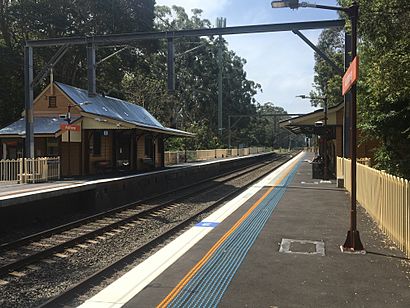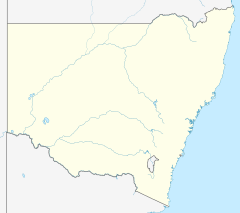Austinmer railway station facts for kids
Quick facts for kids
Austinmer
|
|||||||||||
|---|---|---|---|---|---|---|---|---|---|---|---|

Austinmer in October 2019
|
|||||||||||
| Location | Railway Avenue, Austinmer Australia |
||||||||||
| Coordinates | 34°18′23″S 150°55′45″E / 34.306448°S 150.929248°E | ||||||||||
| Elevation | 70 feet (21 m) | ||||||||||
| Owned by | Transport Asset Holding Entity | ||||||||||
| Operated by | NSW TrainLink | ||||||||||
| Line(s) | South Coast | ||||||||||
| Distance | 68.59 kilometres from Central | ||||||||||
| Platforms | 2 side | ||||||||||
| Tracks | 2 | ||||||||||
| Connections | Bus | ||||||||||
| Construction | |||||||||||
| Structure type | Ground | ||||||||||
| Disabled access | No | ||||||||||
| Other information | |||||||||||
| Station code | AUR | ||||||||||
| Website | Transport for NSW | ||||||||||
| History | |||||||||||
| Opened | 1 September 1887 | ||||||||||
| Electrified | Yes | ||||||||||
| Traffic | |||||||||||
| Passengers (2013) | 160 (daily) (Sydney Trains, NSW TrainLink) | ||||||||||
| Rank | 232 | ||||||||||
| Services | |||||||||||
|
|||||||||||
| Location | |||||||||||
Austinmer railway station is a historic train station on the South Coast railway line in New South Wales, Australia. It serves the town of Austinmer, a northern suburb of Wollongong. This station is special because it is listed on the New South Wales State Heritage Register, meaning it is an important historical site.
Contents
History of Austinmer Station
How Austinmer Got Its Name
The area where Austinmer station stands was first called Sidmouth in 1837. This name came from the house built there by Robert Marsh Westmacott. Sidmouth was also the name of his hometown in England.
By the 1860s, a small farming village grew here and was called North Bulli. The name changed to Austermere when the North Illawarra Coal Company opened a mine. Because another place had a similar name, the spelling Austinmere was used by local newspapers in 1887.
The name is linked to Henry Austin, one of the directors of the Illawarra Mining Company. When the railway platform was built in September 1887, it was named Austinmer, without the final "e".
Opening and Early Days
The station first opened on 1 September 1887. It was a single platform station on the line connecting Scarborough (near Clifton) to Wollongong. It was hard to connect this line to the Sydney to Waterfall section at first. The full connection to Waterfall finally happened on 3 October 1888.
Soon after the station opened, land around it was sold for new homes. Austinmer became famous in the early 1900s as a popular holiday spot. People called it the "Brighton of New South Wales," like a famous beach town in England.
Station Upgrades
The railway line was made into a double line (duplicated) up to Austinmer in 1915. This meant new timber buildings were built on each platform. A steel bridge was also added to connect the platforms. A concrete arch bridge was built for road traffic, and the goods siding (a side track for freight) was closed. Later, in 1917, the goods siding was moved to the Nowra side of the new bridge.
Platforms and Train Services
Austinmer station has two platforms, one on each side of the tracks. NSW TrainLink South Coast line trains use these platforms.
| Platform | Line | Stopping pattern | Notes |
| 1 |
NSW TrainLink
|
services to Waterfall Some trains go to Sydney Central & Bondi Junction during busy times and late at night. |
|
|---|---|---|---|
| 2 |
NSW TrainLink
|
services to Thirroul & Port Kembla Some trains go to Kiama during busy times and late at night. |
Transport Links
Local buses also connect to Austinmer station:
- Dion's Bus Service route 90 goes to Wollongong.
- Dion's Bus Service route 91 goes to the University of Wollongong.
What the Station Looks Like
The station has two main buildings, one on each platform, both built in 1915. There are also the two platforms themselves and the Hill Street overbridge.
The station is located northeast of the Hill Street overbridge. It has small car parks on both sides. To get between the platforms, you need to use the Balfour Road overbridge, as there is no footbridge at the station itself. The station is surrounded by many large trees, making it a leafy place. The buildings were repainted in heritage colours in 2009.
Platform 1 Building
This is the smaller building on the west platform. It is made of weatherboard (timber planks) and has a pointed roof (gabled) made of corrugated steel. A roof extension (awning) sticks out over the platform, supported by steel posts. The ends of the roof have rectangular timber vents.
At the south end, there is a sloped roof (skillion) awning. This side also has two ticket windows, one of which still has its original timber frame. The building has timber-framed windows that slide up and down, and timber doors with small windows (fanlights) above them, some with coloured glass.
Inside, this building originally had a booking office, a waiting room, and ladies' toilets. The waiting area now has modern walls and floor tiles.
Platform 2 Building
This is the larger building on the east platform. Like the other, it is made of weatherboard with a corrugated steel gabled roof. It also has a sloped roof awning over the platform, supported by decorative timber brackets. There is a brick chimney on the roof.
This building has large timber sliding doors facing the platform. Its doors have six-paned fanlights with coloured glass. The ends of the roof timbers (rafters) are visible. The windows are timber-framed and slide up and down, with nine-paned top sections that have coloured glass.
Inside, this building originally had men's and ladies' toilets, a waiting room, and a booking office. The waiting area has been updated with modern ceilings and wall panels.
Platforms
Both platforms were built in 1915 and have asphalt surfaces. They have brick edges with concrete tops in the middle sections. Modern concrete extensions have been added to the north ends of both platforms. Remember, you use the Balfour Road overbridge to cross between them.
Hill Street Overbridge
This is a brick arched bridge at the southern end of the station, also built in 1915. It has brick supports and a curved concrete arch.
Natural Surroundings
The station is in a very green area, located below the Illawarra escarpment (a steep slope). Large native trees form a backdrop to the station and its buildings. You can see views of the escarpment from the Hill Street overbridge and the station itself.
Condition of the Station
In 2009, the station buildings, platforms, and the Hill Street overbridge were all in good condition. The outside of the platform buildings is mostly original, even though the insides have been changed. They still show how the station looked after it was rebuilt in 1915.
Changes Over Time
- 1914–1915: The whole station was rebuilt.
- 1985: The brick platform was made higher.
- 2008: A brick chimney on the Platform 1 building fell down and was removed, and the roof was fixed.
Why Austinmer Station is Special (Heritage Listing)
Austinmer Railway Station is very important because it is a rare example of a station with weatherboard platform buildings. It is historically significant because it was an early station on the Illawarra line (opened in 1887). It also played a role in how Austinmer got its name.
The station is important because it has a group of railway structures from the 1915 upgrade of the Illawarra line that are still mostly original. It has also been a key transport hub for Austinmer since 1887 and helped the town become a popular tourist spot in the early 1900s.
The 1915 platform buildings are also important for their design. They are rare examples of "Federation period" railway buildings made of weatherboard. Together, the platforms, buildings, and road bridge create a complete and attractive railway area within its beautiful natural setting. The 1915 Hill Street overbridge is also special because it used concrete in an innovative way for its time.
Austinmer railway station was added to the New South Wales State Heritage Register on 2 April 1999.
Why it's Historically Important
Austinmer Railway Station is important because it was one of the first stations on the Illawarra line (1887). It helped name Austinmer and has been a transport centre for the village since 1887. Even though there are no original buildings from 1887, the station is important for its role in Austinmer becoming a tourist resort in the early 1900s.
Why it's Beautiful and Well-Designed
The 1915 platform buildings at Austinmer Railway Station are special because they are rare examples of weatherboard station buildings from the Federation period. The way the platforms, buildings, and overbridge are grouped together creates a strong railway area within a lovely natural setting. The 1915 Hill Street overbridge is also technically important for its clever use of concrete.
Why it's Important to the Community
This place helps the local community feel connected to their past. It shows how the area has grown and changed over time.
Why it's Rare
Austinmer is rare because it is one of only four stations on the Illawarra Line (Austinmer, Oatley, Penshurst and Thirroul) that still have weatherboard platform buildings. Austinmer and Penshurst have the most complete examples of these buildings.
Why it Represents a Type of Place
Austinmer Railway Station is a good example of a rural railway station from the Federation period with weatherboard platform buildings that are still largely original on the outside. The stations at Austinmer, Penshurst, Oatley, and Thirroul on the Illawarra line all have examples of this type of building, with Austinmer and Penshurst being the most complete.


